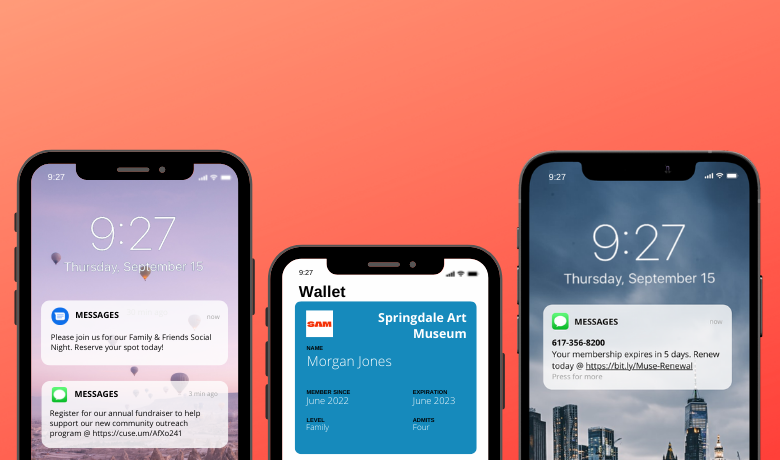We're living in a mobile-driven era, with over 5 billion mobile users worldwide. The influence of mobile technology transcends mere communication, fundamentally altering various industries, including commerce, customer service, and cultural interactions. This technological wave has radically shifted our daily living, molding the core of contemporary society.
Increasingly, cultural institutions like museums are embracing this mobile-centric transformation. The M+R 2022 Benchmarks Study revealed a historical first: the majority (54%) of web traffic for nonprofits now originates from mobile users. Through app-based tours, introducing digital membership cards that use mobile wallets, or utilizing augmented reality, the cultural world is integrating swiftly into the mobile space.
But the revolution doesn't end here. The expansion of 5G, growth of eCommerce, and emergence of SMS marketing present unlimited possibilities. What awaits us next will in regards to technology trends for museums will dramatically reshape cultural organizations. Here's a glimpse into five key mobile technology trends:
1. supercharged Adoption of the Mobile Wallet
Spurred by global changes during COVID-19 and technological advancements, 2022 saw mobile wallets become a favored choice for consumers. Expectations are for a 75% global adoption rate by 2025.
Within the cultural sector, mobile wallets provide easy access to member benefits through contactless digital cards, utilized by hundreds of institutions. The increasing ubiquity of digital wallets also powers mobile ticketing for admissions and events, alongside in-store payments. Museums and best cultural organizations can leverage this trend for smoother customer interactions.
2. omni-channel Engagement with SMS
Technology has long been a crucial asset for museums, but now it's essential to build deeper connections with audiences through mobile channels like email, social media, and particularly SMS Text Messaging.
Gartner's Research Director, Charles Golvin, identifies SMS as a valuable mobile tactic with extraordinary engagement levels. In contrast to average email open rates (28-33%), the open rates for text messages averages about 99%, with 97% read within 15 minutes. The cultural sector too is seeing high click-through rates, making SMS an attractive avenue in 2023 and beyond.
3. Tailoring to a mobile-first landscape
The pandemic has caused a 31% increase in website visits and 43% growth in social media followers for cultural organizations since 2019. With mobile accounting for about half of web traffic worldwide, it is critical for organizations to enhance the mobile user experience by optimizing sites for smartphones.
With this in mind, we can expect to see many cultural organizations working hard to improve their mobile user experience by optimizing their sites and online engagement opportunities for smartphones.
4. the emergence of push notifications
With email losing effectiveness (over 85% of emails are spam as of 2021), push notifications are stepping into the spotlight. With deliverability rates up to 90% and click-through rates up to 7x higher than that of email marketing, push notifications are an essential tool for targeted and personalized communication, appreciated by over 70% of mobile users.
Push notifications offer exceptional benefits, touting significantly higher open and engagement rates than more traditional modes of communication, like email. Plus, they can help reduce churn and improve loyalty and renewal rates!
5. Mobile-Driven eCommerce
The trend towards mobile e-commerce has grown dramatically, with about 80% of smartphone users made purchases through mobile devices last year and 73% of all e-commerce sales carried out via cell phone. Museums and cultural institutions are exploring this space by creating online, mobile-friendly versions of their gift shops like the Smithsonian Store, the Art Institute of Chicago Museum’s shop, and the Met Shop. Despite mobile visitors constituting over half of web traffic in 2022, they accounted for only 45% of donations and 24% of revenue, indicating an untapped potential for conversion into members and supporters. The focus is now on optimizing mobile experiences to bridge this gap.
6. Location-Based Marketing: The New Frontier
Location-based marketing is revolutionizing interactions between brands and customers, with 80% of customers used desired location-based alerts, and 95% of global companies are already using location-based services. Museums are embracing techniques like geofencing to create highly targeted ads and raise awareness. Geo-targeting through a mobile tool like Digital Membership Cards and beacons allows for personalized notifications and effortless wayfinding, turning passersby into potential donors. With Global Location Trends Reporting that 79% of North American marketers using beacon technology, museums are just beginning to explore these tactics. The adoption of geo-targeting and beacon technology by cultural organizations is expected to grow steadily in the coming years.
As mobile technology trends for museums continues to evolve, cultural institutions must adapt with innovative solutions like SMS, mobile e-commerce, and proximity marketing. By providing a unique, forward-thinking mobile experience, they can continue to engage patrons in an ever-changing technological landscape.
Looking to learn more about how mobile solutions can help you drive visitor and member engagement? Schedule a demo with Cuseum.







